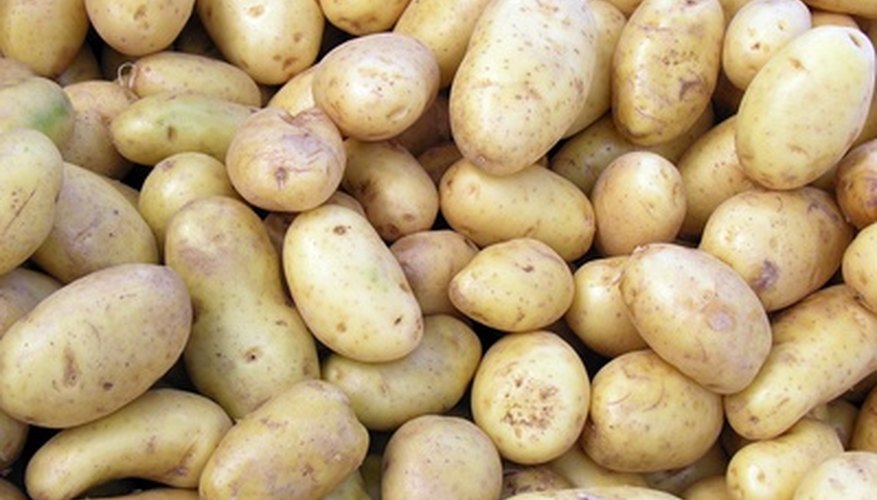Potatoes are an important staple crop. They are rich in complex carbohydrates and a nutritious addition to any diet. Potato skins are very delicate and susceptible to bruising at all stages of harvesting and export. Bruised potatoes can either be an indication of simple surface blemishes or something larger. Conduct a brief visual exam of the tuber to detect whether a potato is suitable for consumption before preparing meals.
Surface Blemishes and Minor Sprouts
Inspect your potato to determine if it has any defects on the skin. Simple bruises that are easily removed with the end of a peeler or knife are generally harmless. Remove these areas during food preparation to avoid a bitter taste. Potatoes that have been sitting out for an extended period may develop "eyes" on the surface of their skin. These minor sprouts or divots should also be removed from the skin during food preparation.
- Inspect your potato to determine if it has any defects on the skin.
- Simple bruises that are easily removed with the end of a peeler or knife are generally harmless.
Blackspot Bruises
Blackspot bruises occur when potatoes that are kept in warm, dry soil conditions are handled roughly during harvest or export. The damaged tissue is visible as a dark grey or black spot on the interior flesh of the potato. Blackspot bruises are not visible on the skin, but are only detectable after the potato has been peeled. Early-stage blackspot bruising can be cut away during preparation. Potatoes with late-stage blackspot bruises should be thrown away.
- Blackspot bruises occur when potatoes that are kept in warm, dry soil conditions are handled roughly during harvest or export.
- Blackspot bruises are not visible on the skin, but are only detectable after the potato has been peeled.
Green Spots
Green spots on the surface of the potato are actually chlorophyll that has developed on the tuber as a result of overexposure to light. The overexposure to light triggers a natural toxin found in potatoes called solanine. Solanine is a toxin the potato uses to guard against fungus and pests. Avoid green spots on potatoes by storing spuds in a cool, dimly lit location. Although a person would have to ingest very large amounts of these green spots to suffer solanine poisoning, it is recommended to always cut the spots away in order to avoid the bitter taste of the toxin.
- Green spots on the surface of the potato are actually chlorophyll that has developed on the tuber as a result of overexposure to light.
Fusarium Dry Rot
Shrivelled brown or black spots on potatoes that are usually dry and run through the internal flesh of the tuber may develop as a result of injury or excessive bruising. Look for visibly dark, shrunken areas on the skin and internal cavities inside the potato to determine if dry rot has developed. Potatoes that suffer from Fusarium dry rot are high in trichothecene toxins and are very dangerous. Dry rotted potatoes should be separated from all other edibles and thrown away.
- Shrivelled brown or black spots on potatoes that are usually dry and run through the internal flesh of the tuber may develop as a result of injury or excessive bruising.
- Look for visibly dark, shrunken areas on the skin and internal cavities inside the potato to determine if dry rot has developed.
